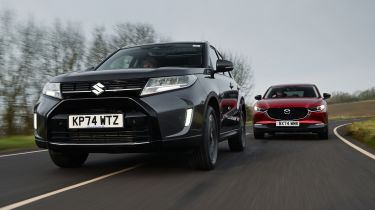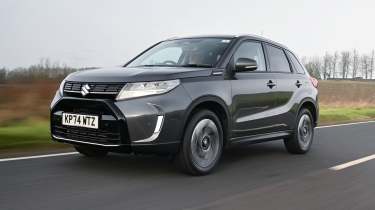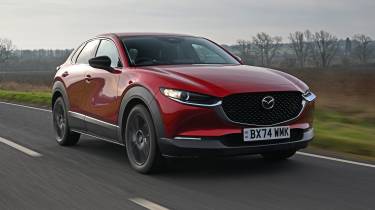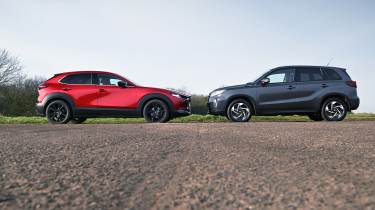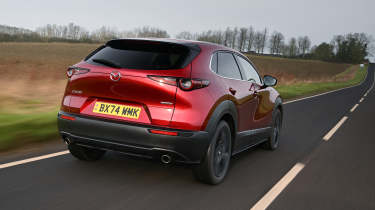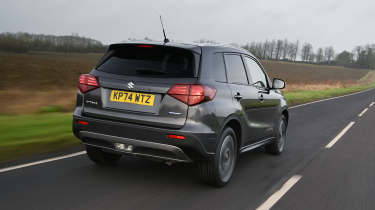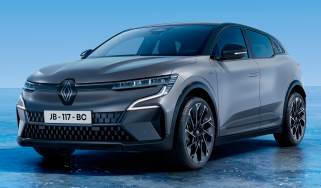Suzuki Vitara vs Mazda CX-30: two small SUVs with some big differences
The 1.4-litre mild-hybrid-assisted , turbocharged Suzuki Vitara takes on Mazda’s 2.5-litre CX-30 in this small SUV face-off
In the late eighties, the arrival of the Suzuki Vitara provided the Japanese company with a small SUV that offered a more family-friendly experience than the other 4x4 in its line-up, the SJ. It also pretty much had a monopoly on the class, because few rivals offered anything similar.
Fast-forward to today, and the small SUV sector is awash with contenders of all shapes and sizes, while powertrains range from petrol to all-electric via different degrees of hybrid assistance. For Suzuki, that means tougher competition, and the fourth-generation Vitara has been given a refresh to help it keep pace with the class front-runners.
Another car that has been updated with the same objective in mind is the Mazda CX-30. It’s the high-riding alternative to the Mazda 3 hatchback, featuring swoopier bodywork than the Suzuki, and as with the 3, it now comes with a 2.5-litre naturally aspirated petrol engine. It’s an interesting choice that highlights Mazda’s engineering ethos, and is in contrast with the Vitara’s smaller turbo unit.
So which option makes more sense? And does either car offer an interesting alternative to the leading models in the small SUV class?
Suzuki Vitara
| Model: | Suzuki Vitara 1.4 Boosterjet Ultra |
| Price: | £28,649 |
| Powertrain: | 1.4-litre four-cylinder turbo petrol mild-hybrid, 127bhp |
| 0-62mph: | 9.5 seconds |
| Test efficiency/range: | 47.8mpg/494 miles |
| Annual VED: | £180 |
When the fourth-generation Suzuki Vitara landed in showrooms back in 2015, it marked a sea change for the company’s small SUV. Gone was the ladder-frame construction in favour of a lighter unibody shell, while front-wheel drive was the most common drivetrain configuration.
Used - available now

2022 Kia
e-Niro
33,290 milesAutomaticElectric
Cash £20,197
2021 BMW
1 Series
60,610 milesAutomaticPetrol1.5L
Cash £17,697
2014 BMW
1 Series
130,000 milesManualDiesel2.0L
Cash £4,498
2014 Ford
C-Max
39,000 milesManualPetrol1.0L
Cash £4,898A decade later, the Vitara’s basic structure remains the same, but it has been given regular updates to keep it fresh. The most recent of these introduced new safety kit and a revised trim structure, while the exterior had a freshen up with a new grille and wheels. Inside, both trim levels (Motion and Ultra) now feature a nine-inch touchscreen display and wireless smartphone connectivity.
Tester's notes
Instead of a touchscreen menu or extra dash buttons, the Vitara’s safety systems are controlled via the trip computer stalk that protrudes from the corner of the dials.
It’s fiddly, because first you have to give it a long press (which can reset the trip if you’re on that screen at the time), then move it from side to side to select options on the dot-matrix display between the dials. If you’re not a fan of speed-limit warnings, then this is a tedious ritual that will need to be undertaken every time you drive.
Mazda CX-30
| Model: | Mazda CX-30 2.5 SkyActiv G Exclusive-Line |
| Price: | £29,165 |
| Powertrain: | 2.5-litre four-cylinder petrol, 138bhp |
| 0-62mph: | 9.7 seconds |
| Test efficiency/range: | 36.7mpg/412 miles |
| Annual VED: | £190 |
In terms of the Mazda model line-up, and the new-car market in general, the Mazda CX-30 falls between classes. It’s a small SUV that’s based on the same platform as the Mazda 3, but it doesn’t have the high-riding stance of the larger Mazda CX-5, and is more like a crossover in terms of its proportions.
There are five trim levels – Prime-Line, Centre-Line, Homura, Exclusive-Line and Takumi – while there are two engines and two gearbox options on offer. Prices start from just under £26,000.
Tester's notes
The CX-30 replaced the Mazda CX-3 in the UK, but it’s just one of a number of CX models that Mazda sells. The CX-3 still exists – the Mazda 2-based SUV is only sold in the Far East now – while the CX-4 is a China-only product.
The electric MX-30 shares its platform with the CX-30, as does the CX-50, a slightly larger version that’s sold in the US and China. At the top of the range, the CX-60 and CX-80 are sold in Europe, while the wider CX-70 and CX-90 are the US versions. To add confusion, the CX-80 and CX-90 replace the CX-8 and CX-9 in the Far East.
Head-to-head
On the road
A low kerb weight and free-revving engine connected to a slick six-speed gearbox help the Vitara feel nimble, and there isn’t much body roll in corners, either. Light controls mean it’s a doddle to manoeuvre, too.
The Mazda feels more car-like to drive, thanks to a lower driving position than its Suzuki rival, while the controls are well weighted and positive. You don’t have to work it as hard to make progress, either.
Tech highlights
While the most recent updates for the Vitara include the addition of wireless smartphone connectivity and a driver monitor, the fact that there’s just one USB socket in the cabin shows the age of the Suzuki’s design.
The CX-30 isn’t much better with two USB sockets, but it also benefits from Mazda’s ‘Multimedia Commander’, the iDrive-style wheel that lets you access the touchscreen quickly and easily.
Price and running
Both cars are well equipped for the price, while fuel-saving tech boosts their everyday efficiency.
The Vitara pulls out an advantage because its smaller-capacity turbo petrol unit is more efficient than the Mazda’s 2.5-litre, and it also comes with 48-volt electrical assistance. Suzuki claims up to 53mpg in test conditions, and we returned nearly 48mpg in our car, compared with 36.7mpg for the CX-30.
Practicality
With its upright body, the Vitara has the looks of an SUV from the previous generation, while smaller proportions – apart from the high roof – mean there isn’t as much space inside as the Mazda. At least there’s a good view out.
The CX-30 has a low-slung driving position that’s not much higher than the Mazda 3’s. This enhances its sporty edge, but the thick C-pillars create a blind spot when you look over your shoulder.
Safety
The Vitara has been brought up to date with safety kit including lane assist and a speed-limit warning, but these are fiddly to adjust within the instrument binnacle and feel as if they’ve been added as part of an aftermarket conversion.
The Mazda’s systems are better integrated, although accessing the menus within the main touchscreen is best done when you’re parked.
Ownership
Suzuki has a loyal customer base that sees it punch above its weight when it comes to Driver Power. The company frequently outscores premium marques, and came 19th in the 2024 survey.
Mazda did better than that, coming seventh out of 32 manufacturers that were rated, with owners appreciating the mix of touchscreen and physical controls inside, as well as the safety kit on offer.
Verdict
Winner: Mazda CX-30
Introducing a larger petrol engine to the CX-30 hasn’t changed much about the overall package, but the extra power and torquier delivery are welcome updates. Even better is that the car’s traditional strengths remain
in place, and this is still a small family SUV that offers the kind of driving fun that’s often hard to come by in this sector.
It’s not the most efficient car in the class, while some rivals offer greater practicality, but decent pricing, a classy cabin and lots of kit mean the CX-30 is worth seeking out.
See our latest Mazda CX-30 deals
Runner-up: Suzuki Vitara
The Vitara feels like a car that’s from a different era, largely because it is. A decade is a long time in the new-car market, and while classic Jimnys and SJs have a ruggedness that helps them to stand the test of time, the Vitara simply feels like a small SUV that has been in production for a bit too long.
It still has its key strengths, such as the efficient Boosterjet engine and surprisingly nimble handling, while the Suzuki ownership experience has its plus points, too, but in most other areas the Vitara is outclassed.
See our latest Suzuki Vitara deals
Prices and Specs
| Suzuki Vitara | Mazda CX-30 | |
| Our choice | Vitara 1.4 Boosterjet Ultra | CX-30 2.5 S’Activ Exclusive-Line |
| Price from/price of our choice | £26,949/£28,649 | £25,865/£29,165 |
| Powertrain and performance | ||
| Powertrain | 4cyl in-line, 1,373cc | 4cyl in-line, 2,488cc |
| Power/revs | 127bhp/5,500rpm | 138bhp/5,000rpm |
| Torque/revs | 235Nm/2,000rpm | 238Nm/3,300rpm |
| Transmission | Six-speed manual/fwd | Six-speed manual/fwd |
| 0-62mph/top speed | 9.5 seconds/118mph | 9.7 seconds/121mph |
| Fuel tank capacity | 47 litres | 51 litres |
| Official fuel economy/CO2 emissions | 120g/km | 136g/km |
| Test efficiency/range | 47.8mpg/494 miles | 36.7mpg/412 miles |
| Dimensions | ||
| Length/wheelbase | 4,175/2,500mm | 4,395/2,655mm |
| Width/height | 1,754/1,514mm | 1,795/1,540mm |
| Rear kneeroom | 615-835mm | 536-790mm |
| Rear headroom/elbow room | 895/1,420mm | 960/1,465mm |
| Boot space (seats up/down) | 362/642 litres (to windows) | 422/1,398 litres |
| Boot length/width | 770/1,020mm | 805/1,010mm |
| Boot lip height | 705mm | 732mm |
| Kerbweight/payload/towing weight | 1,227/423/1,500kg | 1,407/543/1,300kg |
| Turning circle | 10.4 metres | 10.6 metres |
| Costs/ownership | ||
| Residuals (after 3yrs/36k miles, via CDL) | £12,434/43.4% | £13,416/46.0% |
| Depreciation | £16,215 | |
| Insurance group/AA.com quote/VED | 22/£585/£180 | 17/£842/£190 |
| Three-year service cost | £1,080 | £759 |
| Annual tax liability standard/higher rate | £1,646/£3,293 | £1,846/£3,692 |
| Basic warranty (miles)/recovery | 3yrs (60,000)/1yr | 3yrs (60,000)/3yrs |
| Driver Power manufacturer position | 19th | 7th |
| Euro NCAP Adult/child/ped./assist/stars | 89/85/76/75/5 (2015, exp) | 99/86/80/77/5 (2019) |
| Equipment | ||
| Metallic paint/wheel size | £535-£835/17 inches | £600-£850/18 inches |
| Parking sensors/camera | Front & rear/rear | Front & rear/rear |
| Spare wheel/Isofix points | £399/two | Repair kit/two |
| Keyless entry & go/powered tailgate | Yes/no | Yes/yes |
| Leather/heated seats | No/no | No/yes |
| Screen size/digital dashboard | 9.0 inches/no | 10.25 inches/no |
| Climate control/panoramic sunroof | Single zone/yes | Two zone/no |
| USBs/wireless charging | One/no | Two/no |
| Wireless Apple CarPlay/Android Auto | Yes/yes | Yes/yes |
| Blind-spot warning/head-up display | Yes/no | Yes/yes |
| Adaptive cruise/lane assist | Yes/yes | Yes/yes |
Our dealer network has 1,000s of great value new cars in stock and available now right across the UK. Find your new car…

